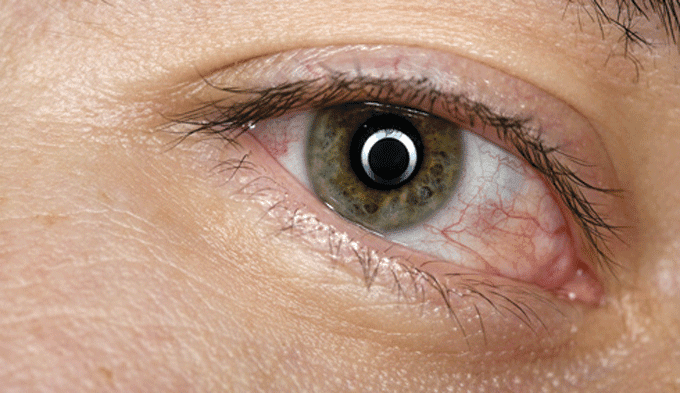
What is conjunctivitis?
Conjunctivitis is an inflammation of the conjunctiva, a transparent membrane covering part of the eyeball and the inner part of the eyelids.
The conjunctiva contains small blood vessels that look like thin red lines on the sclera (the white of the eye) and, when inflamed, give the eye a reddish appearance.
Conjunctivitis is a benign disorder that does not affect vision, but can cause complications if not treated properly.
What causes it?
There are as many types of conjunctivitis as there are factors that cause it:
- Infectious conjunctivitis represents approximately one-third of all conjunctivitis cases and can be caused by bacteria or viruses
- Allergic conjunctivitis occurs when the eyes are exposed to a substance to which the patient is allergic (an allergen), causing an inflammation of the blood vessels in the conjunctiva. The most common causes are dust mites, pollen and other substances from trees, flowers and plants, as well as fungi and epithelial tissue from animals (shedding). Other causes include dry climates or the use of soft contact lenses
- Irritant conjunctivitis is caused by an inflammation of the eyelid (blepharitis), usually resulting from the use of cosmetic products or contact with irritants in the environment (solvents, paints, swimming pool chlorine, etc.)
How can it be prevented?
The best preventative measure is to avoid exposure to allergens. When this is not possible, or appropriate measures have not been taken, and any of the described symptoms appear, the patient should consult an ophthalmologist. In the case of infectious conjunctivitis, other measures should also be taken to prevent infection:
- Not sharing anything that has been in contact with an infected eye (pillowcases, sheets, towels, eye liners, etc.)
- Washing hands immediately if they have been in contact with someone with conjunctivitis
- Not allowing children with the infection to go to school
- Cleaning eye discharges twice a day
- Not wearing contact lenses or makeup
Symptoms
The most common symptoms of conjunctivitis include redness, itching, the sensation of a foreign body or grit, eyelid swelling, watery eyes and discharges.
Complication symptoms can include external pain when opening and closing the eyelids, photophobia, significant swelling of the eyelids or the sensation of a foreign body.
People affected by bacterial conjunctivitis often suffer from a profuse and thick yellow or greenish discharge, and usually wake up with their eyelids stuck together.
Allergic conjunctivitis causes itching and other nasal allergy symptoms (sneezing, obstruction and watery discharge), as well as bronchial (asthma) or skin (dermatitis) complaints.
Treatments
Conjunctivitis treatment varies significantly depending on its cause:
Viral conjunctivitis, as with a cold, has no specific treatment, although special care is recommended by the ophthalmologist, who can help control symptoms and prevent complications
Bacterial conjunctivitis, by contrast, is treated with antibiotic eye drops and usually subsides within a week
Allergic conjunctivitis usually responds well to treatment with antihistamines or can disappear by itself if the causative allergen is removed. Symptoms can be alleviated with cold compresses and, in some cases, topical corticosteroids can be prescribed to reduce inflammation
Irritant conjunctivitis can be minimised by eliminating the cause and administering anti-inflammatory treatment until the eye is back to normal
Specialists who treat this pathology
FAQs
Seasonal eye allergies most affect the eyes in spring and summer, as this is the period of pollination. Seasonal allergic conjunctivitis, which is primarily associated to pollen, is the most prevalent form of eye allergy and its main symptom is itching, as well as redness, water eyes, swollen eyelids and a feeling of burning or of a foreign body.
Another seasonal eye allergy that must be considered is vernal keratoconjunctivitis, which is typical in children and that also often appears in spring and summer. In this case, the symptoms are more serious because, apart from itching, vision can be threatened by the injuries caused to the cornea.
To a greater or lesser extent, conjunctivitis is often associated with watery eyes, as the production of tears – responsible for “cleaning” the eye’s surface – increases like a defence mechanism for the body against any of the factors causing the disorder (virus, bacteria, mites, pollen, chlorine from swimming pools, etc.).
Eye secretions are usually symptoms of external processes such as conjunctivitis or other infections or inflammation. They do not usually constitute a serious condition and can typically be treated with topical antibiotics.
IMO Institute of Ocular Microsurgery
Josep María Lladó, 3
08035 Barcelona
Phone: (+34) 934 000 700
E-mail: international@imo.es
See map on Google Maps
By car
GPS navigator coordinates:
41º 24’ 38” N – 02º 07’ 29” E
Exit 7 of the Ronda de Dalt (mountain side). The clinic has a car park with more than 200 parking spaces.
By bus
Autobus H2: Rotonda de Bellesguard, parada 1540
Autobus 196: Josep Maria Lladó-Bellesguard, parada 3191
Autobuses H2, 123, 196: Ronda de Dalt – Bellesguard, parada 0071
How to arrive at IMO from:
IMO Madrid
C/ Valle de Pinares Llanos, 3
28035 Madrid
Phone: (+34) 910 783 783
See map in Google Maps
Public transport
Metro Lacoma (líne 7)
Autobuses:
- Lines 49 & 64, stop “Senda del Infante”
- Line N21, stop “Metro Lacoma”
Timetables
Patient care:
Monday to Friday, 8 a.m. to 9 p.m.
IMO Andorra
Av. de les Nacions Unides, 17
AD700 Escaldes-Engordany, Andorra
Phone: (+376) 688 55 44
See map in Google Maps
IMO Manresa
C/ Carrasco i Formiguera, 33 (Baixos)
08242 – Manresa
Tel: (+34) 938 749 160
See map in Google Maps
Public transport
FGC. Line R5 & R50 direction Manresa. Station/Stop: Baixador de Manresa
Timetables
Monday to Friday, 09:00 A.M – 07:00 PM







